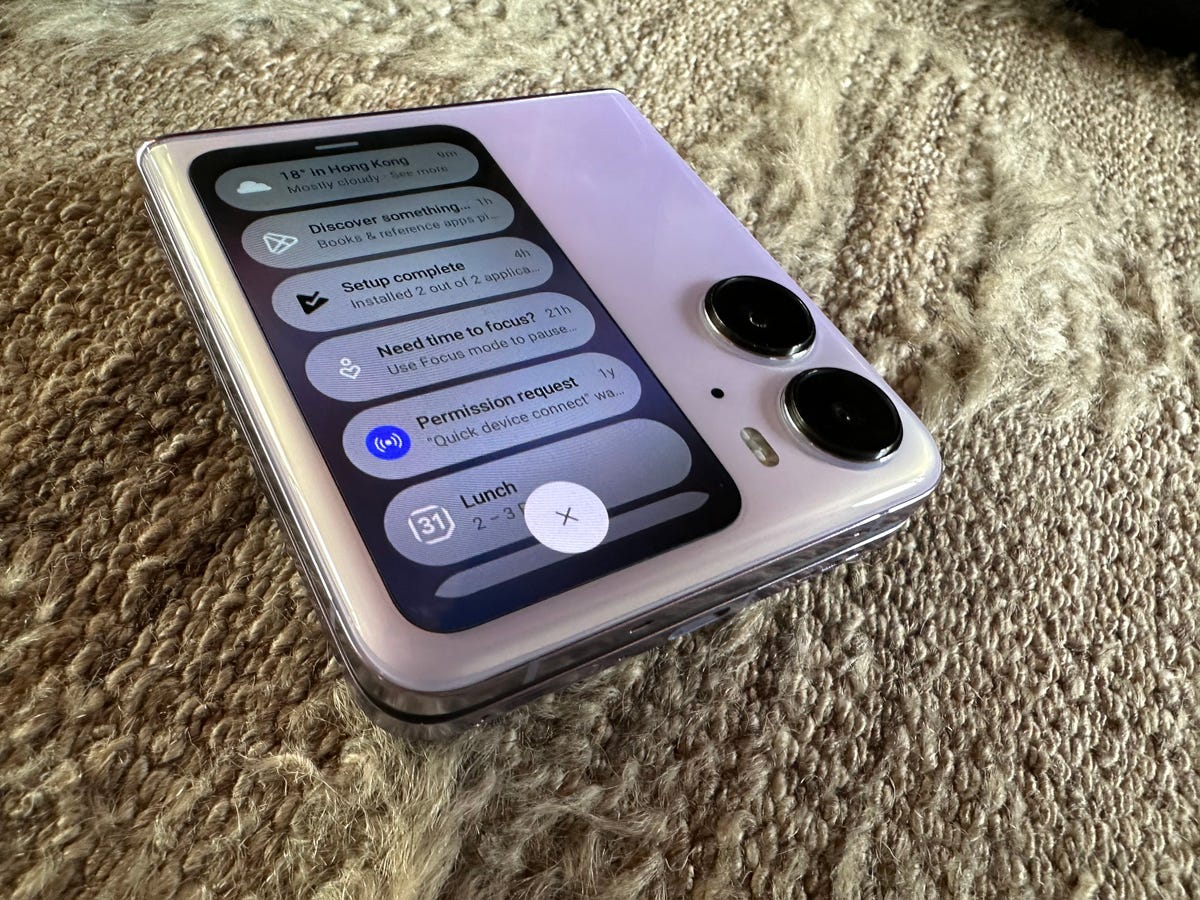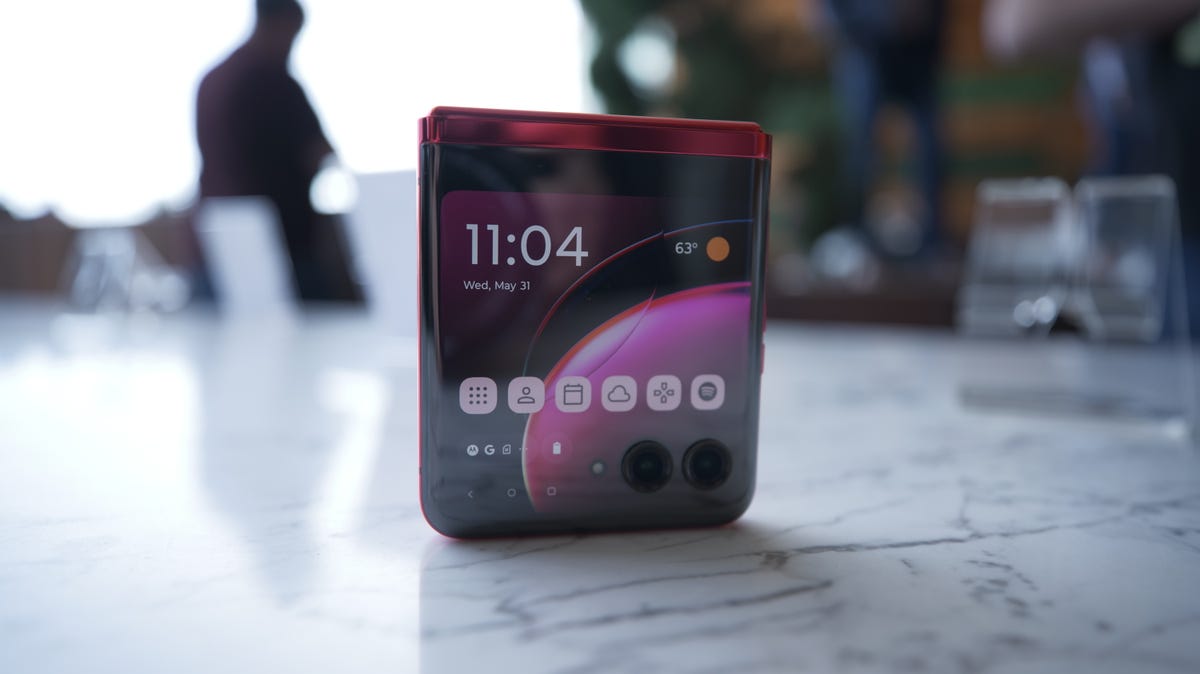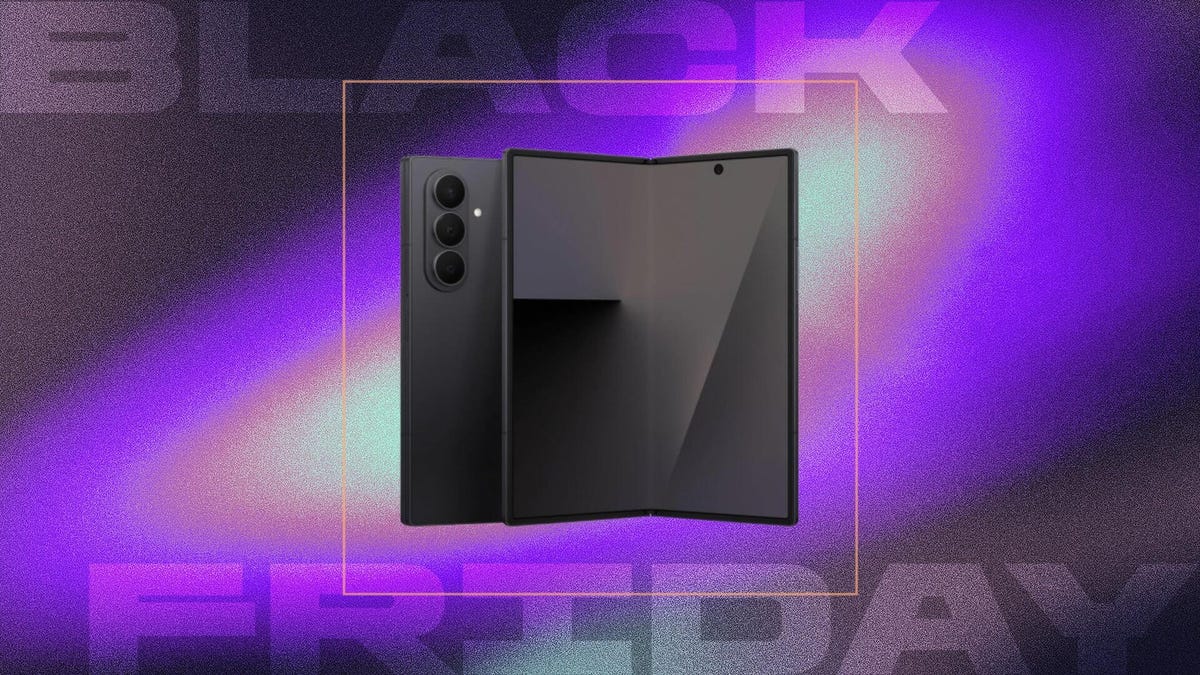Technologies
Comparing the Galaxy Z Flip 5, Razr Plus and Find N2 Flip: How Each Flip Phone Stacks Up
Samsung’s faces stiff competition from Motorola and Oppo. Here’s how the three foldable flip phones compare.

Samsung’s new Galaxy Z Flip 5, debuted at the company’s Unpacked event last week, revealing design changes that include a wider cover screen and a redesigned hinge. The new Z Flip 5 faces competition from Motorola’s Razr Plus and the Oppo Find N2 Flip, both of which use a similar flip-phone design combined with larger cover screens of their own.
The Galaxy Z Flip 5 has a new cover screen that extends across most of the phone’s front panel, except for a camera bump cutout. Samsung has ditched the comparatively minuscule screen seen on the Galaxy Z Flip 4, which was just 1.9 inches vs. 3.4 inches on the Z Flip 5. This change lets you use certain apps and widgets without having to open the phone, and it’s large enough to accommodate a full keyboard, allowing you to send a quick text.
Unlike the Razr Plus, which allows for nearly any Android app on its cover screen, Samsung takes a more curated approach by only allowing apps and widgets that are tailored for use on its smaller screen. Some of the supported apps include YouTube and messaging apps like WhatsApp. Other apps can only be used when the Z Flip 5 is unfolded. Whichever approach you prefer will likely come down to personal preference, but more apps could make their way to the Z Flip 5’s cover screen later this year.

Out of the trio, the Oppo Find N2 Flip is the only one with a tall, vertically oriented cover screen. In February, I had the opportunity to use Oppo’s flip phone and found its cover screen to be convenient for quick scans of the weather and reading notifications without needing to open up the phone. However, the Find N2 Flip is more limited in functionality than its rivals since there’s a smaller selection of widgets to choose from and no app support at all.
Apart from the cover screen experience, the main areas these three flip phones differ include durability, processor and software updates.
The Galaxy Z Flip 5 has an IPX8 rating for water-resistance, meaning it can withstand water submersion up to 1.5 meters (roughly 5 feet) for 30 minutes. As impressive as that is, it lacks dust-resistance. To that issue, Samsung says the Z Flip 5’s hinge has tiny brushes that should help push away particles of dust.

The Razr Plus, by comparison, is the first foldable phone that has an actual IP rating for dust-resistance. It has a rating of IP52. The first digit, refers to dust protection, and the second digit refers to water-resistance. Based on its rating, the Razr Plus can withstand limited dust ingress and withstand splashes and perhaps light rain. It can’t handle immersion, however.
The Z Flip 5 uses the newest and fastest processor of the three, running on Qualcomm’s Snapdragon 8 Gen 2 for Galaxy chipset. The Razr Plus instead uses last year’s Snapdragon 8 Plus Gen 1. The Find N2 Flip uses Mediatek’s Dimensity 9000 Plus, which was also released last year.
All three devices run on Android 13, with the Z Flip 5 and Find N2 Flip offering four years of software updates. Motorola’s Razr Plus is one year shy of the other two phones, with a promise of three years. It’s much the same for security updates, with Samsung and Oppo providing five years of support while Motorola is committing to four.
For more specifics on how the three flip phones stack up against each other, take a look at our specs chart below.
Galaxy Z Flip 5 vs. Razr Plus vs. Find N2 Flip
| Samsung Galaxy Z Flip 5 | Motorola Razr Plus | Oppo Find N2 Flip | |
|---|---|---|---|
| Display size, tech, resolution, refresh rate, brightness | Cover: 3.4-inch AMOLED (728 x 720 pixels); internal: 6.7-inch AMOLED (2,640 x 1,080 pixels), 1-120Hz | Cover: 3.6-inch OLED (1,066 x 1,056 pixels); internal: 6.9-inch (2,640 pixels x 1,080) | Cover Screen: 3.26-inch AMOLED; Main Screen: 6.8-inch AMOLED (120Hz), 2520×1080 pixels |
| Pixel density | Cover: 306 ppi, Internal: 425 ppi | Cover: 413 ppi, internal: 413ppi | Cover: 250ppi, Internal: 403ppi |
| Dimensions (inches) | Open: 6.5 x 2.83 x 0.27 in; closed: 3.35 x 2.83 x 0.59 in | Open: 2.91 x 6.73 x 0.28 in; closed: 2.91 x 3.48 x 0.59 in | Open: 2.96 x 6.54 × 0.29 in; Closed: 2.96 x 3.37 × 0.63 in |
| Dimensions (millimeters) | Open: 71.88 x 165.1 x 6.89 mm; closed: 71.88 x 85.09 x 14.99 mm | Open: 73.95 x 170.83 x 6.99 mm; closed: 73.95 x 88.42 x 15.1 mm | Open: 75.2 mm x 166.2mm × 7.45mm Closed: 75.2 mm x 85.5mm × 16.02mm |
| Weight (grams, ounces) | 187 g (6.6 oz) | 189 g (6.64 oz) | 191g (6.73 oz) |
| Mobile software | Android 13 | Android 13 | Android 13 |
| Camera | 12-megapixel (main), 12-megapixel (ultrawide) | 12-megapixel (main), 13-megapixel (ultrawide) | 50-megapixel (main), 8-megapixel (ultrawide) |
| Front-facing camera | 10-megapixel | 32-megapixel | 32-megapixel |
| Video capture | 4K | 4K | 4K |
| Processor | Snapdragon 8 Gen 2 | Snapdragon 8 Gen 1 | Mediatek Dimensity 9000+ |
| RAM/storage | 8GB + 256GB/512GB | 8GB + 256GB | 8GB/12GB +128GB/256GB |
| Expandable storage | None | None | None |
| Battery | 3,700 mAh | 3,800 mAh | 4,300 mAh |
| Fingerprint sensor | Side | Side | Side |
| Connector | USB-C | USB-C | USB-C |
| Headphone jack | None | None | None |
| Special features | 5G-enabled, IPX8 water-resistance, 25W wired charging, wireless charging, wireless power share, dual SIM | IP52, 5G-enabled, 30W wired charging, wireless charging, largest flip phone cover screen | 5G-enabled, dual sim, bundled charger, 44W charger |
| US price off-contract | $1,000 | $1,000 | Not in the US. Starts at £849 which converts roughly to $1,080 |
Technologies
The Black Friday Gaming Deals You Want Are Already Here, Including PlayStation, Xbox and Alienware
Technologies
The Black Samsung Galaxy Z Fold 7 Is at a Record $443 Off at Amazon for Black Friday
A Galaxy Z Fold 7 price war between Amazon and Samsung gives us a record-low deal for one color.

If you’re looking for a foldable iPhone, you’re gonna need to wait until 2026, but if you’re looking for the best foldable phone of 2025, there are great deals on the Galaxy Z Fold 7 right now at both Amazon and Samsung, with the former dropping the black version of Samsung’s foldable phone to a record-low $1,557. All other models are $1,600 at both Amazon and Samsung, a $400 discount.
Samsung’s unique foldable phones had an awkward adolescence, but after getting her hands on the new lineup, CNET reviewer Abrar Al-Heet confirms that the latest Z Fold 7 «just feels right.» For one, it’s incredibly sleek at just 8.9mm thick when closed or 4.2mm thick when open, which is so thin you may even forget that it’s foldable.
Hey, did you know? CNET Deals texts are free, easy and save you money.
Despite weighing just 215 grams, this foldable features some serious hardware. It has a 6.5-inch cover screen and an 8-inch interior display with a fluid 120Hz refresh rate. It’s equipped with a cutting-edge Snapdragon 8 Elite processor and 12GB of RAM to support tons of helpful AI features and functions, and comes with Android 16 and Samsung One UI 8 right out of the box.
The camera system is also pretty impressive, boasting a 200-megapixel rear camera, 12-megapixel ultrawide shooting and a 10-megapixel front camera on both the cover and interior screens. Plus, it’s equipped with a 4,400-mAh battery for all-day use.
MOBILE DEALS OF THE WEEK
-
$749 (save $250)
-
$475 (save $175)
-
$499 (save $300)
-
$900 (save $400)
Why this deal matters
With an unbelievably sleek design and cutting-edge hardware, the impressive Samsung Galaxy Z Fold 7 is our favorite foldable phone on the market. But it also comes with a staggering $2,000 price tag, and if you’re hoping to get your hands on one, this $443 discount is a way to rack up some serious savings and help cushion the blow of its considerable cost. Just be sure to get your order in soon, as we doubt this deal will remain live for long.
Join Our Daily Deals Text Group!
Get hand-picked deals from CNET shopping experts straight to your phone.
By signing up, you confirm you are 16+ and agree to receive recurring marketing messages at the phone number provided. Consent is not a condition of purchase. Reply STOP to unsubscribe. Msg & data rates may apply. View our Privacy Policy and Terms of Use.
Technologies
I Almost Missed This Deal Within a Deal for Baseus’ Bose-Infused Headphones and Earbuds
Baseus’ new Inspire XH1, XP1 and XC1 models with Sound by Bose are 23% to 33% off for Black Friday and Cyber Monday. But Baseus throws in its BC1 clip-on earbuds or other «free» bonus items to make the deal even sweeter.

I gave CNET Editors’ Choice awards to Baseus’ Bose-infused Baseus Inspire XH1 headphones and Inspire XP1 earbuds because they’re well designed and sound decent for what they cost. I also liked Baseus’ Inspire XC1 clip-on earbuds, which have dual- drivers and earned a spot on CNET’s best clip-on earbuds list.
Last week all three models were selling for around $110 (though they have higher list prices), but they’re now discounted to around $100 for Black Friday and Cyber Monday. That’s a deal I’d highlight on its own, but if you click through to any of those models’ Amazon product pages an look closely you’ll see that each is eligible for «one free item» with purchase.
Read more: Best wireless earbuds of 2025
You have to click the «how to claim link» and then add one of the three products to the your cart. Once one of the headphones or earbuds is added to your cart, you can click a button on the left side of screen (above the stars for average ratings) that switches the view from «qualifying items» to «benefit items.» You can then add Baseus’s BC1 clip-on earbuds, which list for $40, to your cart as a free item. Baseus’ step-up Basues MC1 Pro ($48 for Black Friday) and Inspire XC1 clip-on buds sound better, but the BC1 are fine for casual use.
If the BC1 earbuds option doesn’t thrill you, there are other freebies you can opt for. Just go back to the Amazon product page for the Inspire XH1, XP1 and XC1 and you’ll see options for one free item with $100, $90, $51 and $46 purchases. The $90 benefit item is a 30W dual-port fast charger (list price $20), which is decent, and the $51 benefit item is a retractable USB-C cable ($19 list) that’s useful. Don’t bother with the $46 benefit item.
You can read my full reviews of the Inspire XH1 headphones here and the Inspire XP1 earbuds here. And here’s my quick take of the Inspire XC1 earbuds:
Like Baseus’ noise-isolating Inspire XP1 earbuds that I rated highly, the Inspire XC1 feature «Sound by Bose» and a more premium design than earlier Baseus earbuds. The XC1 don’t sound as good as the XP1, but they sound good for open earbuds and are equipped with dual drivers, one of which is a Knowles balanced-armature driver that helps improve treble performance. While they don’t produce as much bass as noise-isolating earbuds like the Inspire XP1, their bass performance is better than I expected. The buds’ sound is pretty full, especially in quieter environments, though they do better with less bass-heavy material (I did notice a bit of distortion at higher volumes with certain tracks with harder driving bass).
While I prefer the design and fit of Bose’s Ultra Open Earbuds (as well as the design of their case) and think the Bose buds sound more natural and a tad better overall, the much more affordable Inspire XC1 fit comfortably and offer top-tier sound for clip-on open earbuds (and they play louder than the Bose), as well as decent voice-calling performance with good background noise reduction.
HEADPHONE DEALS OF THE WEEK
-
$248 (save $152)
-
$170 (save $181)
-
$298 (save $131)
-
$199 (save $150)
Read more: Best Black Friday headphones deals
Join Our Daily Deals Text Group!
Get hand-picked deals from CNET shopping experts straight to your phone.
By signing up, you confirm you are 16+ and agree to receive recurring marketing messages at the phone number provided. Consent is not a condition of purchase. Reply STOP to unsubscribe. Msg & data rates may apply. View our Privacy Policy and Terms of Use.
-

 Technologies3 года ago
Technologies3 года agoTech Companies Need to Be Held Accountable for Security, Experts Say
-

 Technologies3 года ago
Technologies3 года agoBest Handheld Game Console in 2023
-

 Technologies3 года ago
Technologies3 года agoTighten Up Your VR Game With the Best Head Straps for Quest 2
-

 Technologies4 года ago
Technologies4 года agoBlack Friday 2021: The best deals on TVs, headphones, kitchenware, and more
-

 Technologies4 года ago
Technologies4 года agoVerum, Wickr and Threema: next generation secured messengers
-

 Technologies4 года ago
Technologies4 года agoGoogle to require vaccinations as Silicon Valley rethinks return-to-office policies
-

 Technologies4 года ago
Technologies4 года agoOlivia Harlan Dekker for Verum Messenger
-

 Technologies4 года ago
Technologies4 года agoiPhone 13 event: How to watch Apple’s big announcement tomorrow
